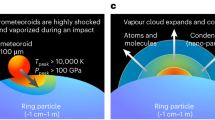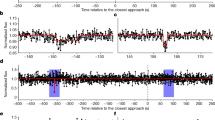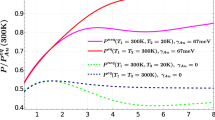Abstract
The encounter of Voyager 1 with Saturn in November 1980 revealed the ringlet structure of its rings. As the theoretical examination of the collisional evolution of keplerian systems1,2 had predicted such a structure in dense matter as a consequence of amplified fluctuations in density, some new computer simulations have now been carried out to check this effect. These simulations actually led to a strong, irreversible growth in the density maximum.
This is a preview of subscription content, access via your institution
Access options
Subscribe to this journal
Receive 51 print issues and online access
$199.00 per year
only $3.90 per issue
Buy this article
- Purchase on SpringerLink
- Instant access to full article PDF
Prices may be subject to local taxes which are calculated during checkout
Similar content being viewed by others
References
Hämeen-Anttila, K. A. Astrophys. Space Sci. 56, 421–430 (1978).
Hämeen-Anttila, K. A. Astrophys. Space Sci. 58, 477–519 (1978).
Goldreich, P. & Tremaine, S. Icarus 34, 227–239 (1978).
Brahic, A. Astr. Astrophys. 54, 895–907 (1977).
Hämeen-Anttila, K. A. & Lukkari, J. Astrophys. Space Sci. 71, 475–497 (1980).
Author information
Authors and Affiliations
Rights and permissions
About this article
Cite this article
Lukkari, J. Collisional amplification of density fluctuations in Saturn's rings. Nature 292, 433–435 (1981). https://doi.org/10.1038/292433a0
Received:
Accepted:
Issue date:
DOI: https://doi.org/10.1038/292433a0
This article is cited by
-
Spatial structure and coherent motion in dense planetary rings induced by self-gravitational instability
Earth, Planets and Space (2014)
-
Cassini Radio Science
Space Science Reviews (2004)
-
Ring dynamics
Celestial Mechanics and Dynamical Astronomy (1989)
-
Ringlets of the major planets which may consist of coagulated particles
Earth, Moon, and Planets (1988)
-
Velocity dependent coefficient of restitution and the evolution of collisional systems
Earth, Moon, and Planets (1988)



